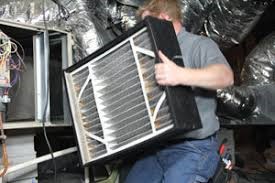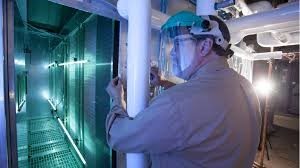Give your workforce and user community peace of mind with health and safety improvements
At this point, the impact and duration of the COVID-19 pandemic is still unknown, but one thing is certain: Your workforce will be coming back after the dust settles.
- Will your building be ready for them?
- Will you utilize this time wisely to posture your building and habitat for the health and well-being of your community?
- Are you taking the necessary measures to be a leader in the New Post-Pandemic World?
While this period of time represents a challenge for many organizations, it also presents an unprecedented opportunity to invest in the health and safety of your assets through major systems like filtration, air exchange, air stream disinfection and preventative cleaning. As a strategic partner, UG2 can work with you to ensure that your upfront investment pays off with a much more efficient building that protects your employees, visitors and assets.
Lately, there has been extensive focus on additional cleaning, sanitizing and disinfecting processes for all high-touch surfaces and while that’s still crucial, what about your HVAC system? Consider that this is what’s supplying clean air to your building’s occupants.
HVAC and Refrigeration systems play a critical role in the prevention of the spread of infectious disease. Reviewing and understanding the American Society of Heating Refrigeration and Air Conditioning Engineers (ASHRAE) guidance* for air exchanges within a space, temperature, humidity and pressure relationships, filtration requirements, and the use of ultraviolet germicidal irradiation (UVGI) to protect building occupants should be top of mind to any building owner or manager.
The Centers for Disease Control and Prevention (CDC) recommends that facilities increase air circulation and filtration wherever possible. Within our own industry, ASHRAE has been proactive, compiling resources and publishing a thorough library that covers preventative actions building owners can take for virus outbreaks as it relates to HVAC Systems. Follow this link for additional information:
https://www.ashrae.org/file%20library/about/position%20documents/airborne-infectious-diseases.pdf
ASHRAE has also put together a comprehensive collection of online resources that includes research papers, seminars, handbooks , and more which can be found by following the link below.
https://www.ashrae.org/technical-resources/resources
With buildings now empty, it’s an ideal time for actions like these:
- Replacement of filters, including those in air handling units, VAV boxes & fan powered terminal boxes. This can eliminate potential contaminants that travel within the airstream. Also, companies should look to increase the minimum efficiency MERV rating value on their air filters. (ASHRAE recommends MERV 8 or higher to provide a higher level of filtration in an office building. For some healthcare applications MERV ratings of 17 or higher are applicable to provide HEPA & ULPA levels of filtration.) Additionally, look to tape the seams of your filters with duct tape to prevent any unfiltered air penetrating your coils and recirculating into occupied spaces.
- Advanced deep cleaning, such as disinfecting cooling & heating coils and condensation pans, as well as all parts of a system involved in air exchange. Cleaning coils with an antibacterial cleaner will mitigate the risk of many viral contaminants making it to the airstream.
- Using Ultraviolet Germicidal Irradiation (UVGI) light to disinfect HVAC coils in large air handlers should be considered. The benefit is to improve indoor air quality (IAQ) and provide clean, efficient HVAC operation with reduced maintenance and energy costs.
- UVGI is a disinfection method that uses short-wavelength ultraviolet (ultraviolet C or UVC at 280-100nm wavelength), light to inactivate a microorganism through the destruction of its nucleic acids and disrupting their DNA. The light generated by the lamps are designed to kill microorganisms on coils, surfaces, in water and/or in the airstream—including mold, flu viruses and bacteria. These systems are similar to what hospitals and the airline industry use to disinfect airplanes and ORs. UVC light provides the most benefit where humidity levels increase during the summer months.
- Painting the floors with microbiological paint in mechanical and equipment rooms is a low-cost, high-impact strategy for reducing dust and other particulates that can get into the building’s air handling system. Not only does this type of paint kill multiple types of contaminants upon application, it also makes surfaces resistant to microbes for years afterward.
- Maintenance and cleaning of summer-related systems like roof top air conditioning to ensure they are working well, and proper air exchange levels are set.
- Remember to change your water filtration media. If you don’t currently have water filtration, this is a great time to install them. This will eliminate potential contaminants, such as those that develop when water sits stagnant in a system and can turn into a potential legionella risk.
- Installation of touchless bathroom fixtures, including urinals, toilets, faucets, soap dispensers, automatic paper towel dispensers, purleve solutions and automatic air sanitizers, will provide a more sanitized environment within your restrooms and can have the added benefit of reducing energy consumption (and cost).
- Priming plumbing traps. With buildings being empty for several months, no water is consistently flowing through sanitary and storm water drain lines, causing floor drain traps to dry and sewer gases to back up. Adding water, enzymes or peppermint oil to the traps now can eliminate the risk of this potentially significant issue.
- Steam trap replacement and infrared studies can provide additional economic benefit, and with buildings being less occupied, resulting maintenance like torque down to reduce friction or Megger testing to ensure proper insulation of motors can be conducted with less business interruption.
Strategies like these are challenging to deploy during normal operations, and usually involve bringing in engineering specialists on off-hours (evening, weekend, holiday) situations, or doing this type of work on a rolling basis. But the current significantly reduced occupancy rates, offer an opportunity for this work to be performed more efficiently and effectively. UG2 has proactively streamlined the supply chain and availability of the essential inventory for these upgrades to ensure the timely completion of these initiatives.
Best of all, bringing in professionals now creates environments that are better geared towards preserving the health and safety of your employees and community, and provides cost savings and competitive advantage for you. Now is the time to act and seize this moment.
*This refers to the ASHRAE March 23, 2020 letter to the World Health Organization to ensure you are addressing COVID-19 concerns with respect to the operation and maintenance of your HVAC systems.

